SPOILERS COMING OUT THE WAZOO!!!
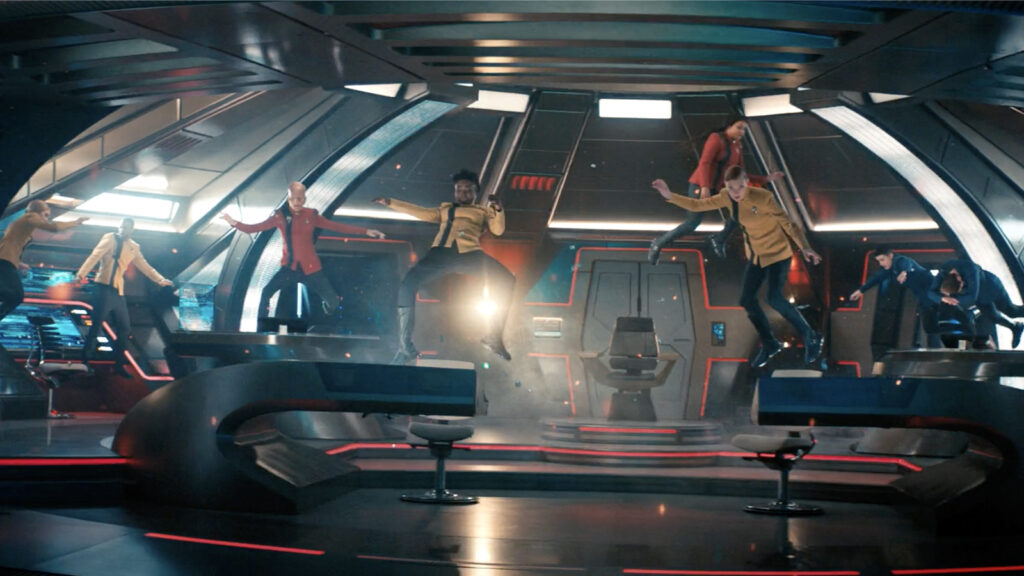
First of all, VCBS moved quickly to (try to) clean up their “mess” from last week, now debuting STAR TREK: DISCOVERY season 4 internationally on Paramount+ and Pluto TV in at least some countries this week, releasing episodes 1 and 2 together. It’s far from a perfect fix, but at least I don’t have to worry about spoilers as much as I did last week when only fans in the U.S., Canada, and those with a questionably moral compass could view it.
So let’s jump into the second episode of the season, “Anomaly,” or as I like to call it: “Quiet Conversations Punctuated By Action Scenes and Technobabble in the Middle.”
Okay, stop, stop, stop! I did NOT hate the episode. And I didn’t love it either. But here’s the thing, folks: I should have loved it.
The reason that I should have loved “Anomaly” is that it corrected many, MANY things that I’ve been complaining about for three seasons now. And for those of you who don’t make it a point of memorizing Jonathan’s list of grievances, here’s a brief Festivus refresher of what has most grated on me and what this episode did to fix those issues…
Characters weren’t given time to react and process traumatic events
I remember my go-to example of this was when the crew of Discovery got back from the Mirror Universe in season one, having been betrayed by their former commanding officer (Lorca). He turned out to be an evil psychopath who tried to kill them all. And the only “traumatized” emotional reaction we got from any of the characters was when Admiral Cornwell phasers an innocent bowl of fortune cookies out of existence. Everyone else, it seems, was fine.
The problem with the series in the first two seasons was a rush to hit the major story “beats” (significant events that change the characters’ direction in some major way), and once a beat happened, there was a rush to the next beat, and so on and so on. The writers didn’t give the characters a chance to breathe.
This episode, on the other hand, had Book dealing with the destruction of his home world, Michael dealing with her feelings for Book affecting her command instincts, Tilly dealing with what happened on the space station last episode and all the events from season three, Adira dealing with both Tilly as well as uncertainties about Gray’s upcoming transition (interesting choice of wording) from disembodied mind-ghost to full-bodied Soong-type synth, and Stamets’ ongoing feelings of inadequacy and helplessness to save his family that led to him getting shot out of an airlock in season three.
So we went from almost no characters having lingering traumas to almost no characters NOT having lingering traumas. That’s what I wanted, right? Well, let me get back to you on that after I continue with the ol’ airing of the grievances…
Characters only interact when Michael Burnham is in the scene with them
This was a huge issue for me. Even as recently as last season (but certainly throughout the first two seasons), characters didn’t get a chance to develop unless Michael Burnham was in the scene with them. Granted, there were exceptions: Lorca and Cornwell making out, Stamets and Dr. Hugh brushing their teeth, and any scenes that happened away from Discovery like Pike and Vina or Georgiou with Section 31. And of course, when Michael was separated from the crew at the beginning of season three, the crew got a brief chance to interact with each other. But for the most part, the characters on the series all seemed like spokes from a wheel with Michael Burnham as the axle.
Not this episode! We had scenes between Book and Stamets, Tilly and Adira, Adira and Gray (well, we’ve had lots of those), Tilly and Saru, Stamets and Hugh (well, we’ve had lots of those, too), and Tilly and Hugh (that’s new). Michael got her coupling, as well, with Book (of course) and with Saru, but at least she wasn’t there in every scene.
Not enough humorous or light-hearted moments
Man, this show started out dark! And while ANSON MOUNT as Pike brought in some welcome relief from all the doom and gloom, and Tilly was always there to play jester, for the most part, lighter moments were few and far between. And while this episode was certainly no “Trouble with Tribbles,” we did get some smile moments…and not just from Tilly this time.
We didn’t learn the bridge crew’s names because no one ever spoke them aloud
I used to kvetch saying, “It’s so easy to fix this problem! Just have the captain give an order TO someone: ‘Detmer, get us out of here,’ ‘Okosekun, lay in an evasive course,’ ‘Rhys, what’s the tactical situation?'” Of course, this also meant actually giving the bridge crew something to do…also a failing of earlier episodes.
This time, nearly every order was accompanied by the name of the character it was being addressed to. Thank you! Finally!!!
Too much swearing
We made it nearly all the way through this episode before someone dropped an s-bomb. And three guesses who it was. Hint: her name rhymes with “silly.”
Michael Burnham must always save the day
- The first rule of Star Trek: Discovery – Michael Burnham must save the day.
- The second rule of Star Trek: Discovery – Michael Burnham must save the day.
- The third rule of Star Trek: Discovery – no one talks about Fight Club.
- The fourth rule of Star Trek: Discovery – once you have their money, you never give it back (no wait, that’s the First Rule of Acquisition.)
Anyway, this episode had Book and Stamets save the day…although Michael needed to help in a way that only she could. Someday soon, I hope the writers will break their addiction to Michael as savior, but in the meantime, this was at least a small step in that direction. You can do this, writers—I believe in you!
Okay, so why didn’t I love this episode? Jeez, where to begin…
There’s a few things that accomplished scriptwriters will offer you as advice:
- Show, don’t tell.
- Avoid scenes with large amounts of dialog filled with complex exposition.
- Most scenes you write will be too long—trim them, trim them some more, then walk away from your script, come back, and trim them some more. Repeat as necessary.
- Be extra careful of 2-person scenes: they’re a powerful tool, but they can become a trap.
You might have noticed how this episode seemed to go from ultra-slow to ultra-fast and then back again. The same was actually true of the previous episode, as well, but there was a difference. Last week, the two-person scenes with Saru and Su’kal were relatively short and didn’t take up much of the episode. The quiet scenes of Book with his family on Kwejian were likewise brief and quickly turned from quiet dialog into major plot twist. Also, the slow scenes were pretty evenly interspersed with the action and intense drama scenes. In other words, the pacing of the first episode of the season was reasonably good and balanced.
“Anomaly” not so much…
Essentially, this episode was structured as follows. Of the 46.5 minutes of actual story (there’s 1 minute of recap, 1.5 minutes of opening credits, and about a 1 minute of closing credits), here’s how the episode was paced…
- 23.5 minutes of slow,
- followed by 15 minutes of action,
- followed by 8.5 minutes of slow.
Now, that first 23.5 minutes isn’t completely slow. About 10 minutes is filled with “group” scenes that have some urgency and tension: the command conference at Starfleet HQ and the bridge scenes as Discovery heads out to the anomaly. Those scenes, even though they’re filled with discussion and copious technobabble, they are fairly engaging.
The other 13.5 minutes of the first half are scenes with either two people (Burnham and Book, Burnham and Saru, Book and Stamets) or three people (Hugh, Adira, and Gray—if you can count that as a “full” three—and Michael, Hugh, and Stamets). And each of those scenes is very quiet and introspective.
Then there’s all of the action packed into the next 15 minutes. And finally, the episode winds down a with series of slow, introspective 2-person scenes again: Stamets and Book, Stamets and Hugh, Hugh and Tilly, Adira and Gray, Michael and Book, and then Saru and Tilly.
Now, don’t misunderstand—there’s nothing inherently wrong with slow, quiet 2- and 3-person scenes. They’re great for character development and can move dramatic sub-plots forward very effectively. But these kinds of introspective scenes are NOT a case of “If a little is good, then a lot must be better.”
It’s all about the pacing, and this episode started at half-thrusters for nearly half the time, then it jumped to maximum warp, and finished off back at half thrusters. Sure, we were graced with some wonderful character development, but we were also burdened with a whole bunch of (required) exposition delivered to the audience in large, plodding chunks. Among these were:
- Michael explaining that Book is in “so much pain” and hasn’t wanted to talk for the past two days.
- Michael is blaming herself for the three deaths from the previous episode.
- Saru’s status regarding Kaminar as a “counselor in absentia” because he’s needed in Starfleet now.
- Saru was offered a command and turned it down in order to be Michael’s Number One.
- The explanation of the two giant black holes and why they’re such a threat (and why Discovery needs to jump close to them and get sensor data).
- Apparently, Tilly thinks Saru is taller now…is that something important?
- Tilly is having an existential crisis.
- Explaining why only Book’s ship can go into the anomaly…and why Book has to pilot it.
- A LOT of exposition about Gray’s new Soong-method synthetic (Soongthetic?) android body: it was used successfully on a 24th century admiral named Picard (Easter egg!), it’ll age, it can be sculpted in any way the user wants, and it’s not a cure for death as it doesn’t always work (although, don’t you think that people on their death beds would still be lining up to at least try?).
- More on the reasons for Book’s current emotional state…and Michael’s command dilemma. Oh, and apparently Discovery‘s sentient ship’s computer has named herself “Zora.” Thanks for telling us about that.
- Quite a bit of explaining about how Stamets’ holo will work and what the tether is going to be used for. And of course, we need the audience to know that Stamets and Book haven’t exactly been BFFs lately. The writers actually tell us that twice, once in a conversation between Stamets and Hugh and again once Stamets gets onto Book’s ship and tries to strike up a conversation.
- Make sure the audience knows that only Stamets can get the sensor data because Book wouldn’t know what to look for. So Book’s job is simply piloting, and Stamets’ job is to run scans.
Ya got all that?
Let’s face it—that is a HUGE amount of information to cram into the first half of any episode, but at least now the audience is loaded up with the Cliff’s Notes in order to enjoy the next 15 minutes of action. Then, once everyone is safe again, we get more slow scenes neatly wrapping up any character conflicts that emerged this episode plus some final exposition between Tilly and Saru establishing that, indeed, we have a BIG problem.
You might have noticed a few times that I used the word “tell” in the above list…even italicizing it once. Remember when I said a writer should “show, don’t tell”? That’s the trap of quiet 2-character dialog scenes: they make it too easy to tell and not show—like telling us the ship’s computer has now named herself Zora. There’s nothing wrong with using quiet 2-person (and 3-person) scenes to share a little exposition…after all, the audience shouldn’t be completely clueless, and this is a convenient way to present explanations to them. But if you’ve got as much plot exposition in your first 25 minutes as I just described above, then you either 1) have too complex of a plot and need to simplify things a little, 2) are trying to juggle too many storylines simultaneously and aren’t really doing any of them much justice, or 3) you don’t trust your audience to figure things out as the episode and storylines naturally evolve.
I think this episode suffered a little bit from each of those three shortcomings. And that’s why I say, “If a little is good, a lot is not necessarily better.” Yes, hooray for fixing all of the problems I cited at the beginning of this blog! But maybe limit the number of characters with “issues” to just two or three or maybe at most four in an episode. “Anomaly” had Book, Michael, Tilly, Adira, AND Stamets—five characters!—all with dramatic problems. Plus we have the anomaly to deal with and a bridge that has air vents that spontaneously burst into flames at regular intervals during red alerts.
What is with those sporadic flaming vents anyway??? I mean, I understand the need for merchandising, but DISCOVERY BRIDGE: THE FLAME-THROWER seems a bit derivative of Spaceballs, don’t you think?
Seriously, though, this is an example of just because you can do something (add practical VFX so that parts of the bridge burst into flames for extra visual peril) doesn’t mean you should. Each time I see those flames pop up at semi-regular intervals, I just think: “What system would be spitting bursts of hot fire through the vents when the ship is damaged…and why isn’t that system removed? After all, in addition to not wanting to barbecue your bridge officers, fire when there’s a finite supply of oxygen on your ship is NEVER a good thing!”
Oh, and as long as I’m kvetching, another example of the “just because you can…” philosophy of VFX was the anti-gravity wave hitting the ship. Sure, maybe it looks cool to attach harnesses to all the bridge actors and lift them all out of their seats so they can hover in midair until gravity is restored. But that’s not how gravity and anti-gravity work, people! When gravity gives out, you either stay where you are until you push off of something or else you start floating in a direction and you don’t stop until you hit something else—a wall or a ceiling or the floor or a chair or something. You don’t lift five feet off the floor and just hover. So minus points for ignoring physics…and seat belts!
Okay, that’s enough griping for one blog. As I said, I didn’t hate the episode. And it did start fixing many problems and shortcomings that I used to complain about incessantly. So I am going to end this blog trying to see this as a step in the correct direction. The glass is half-full, right?
Now, let’s see if the writers can add some more water into the cup for next time.


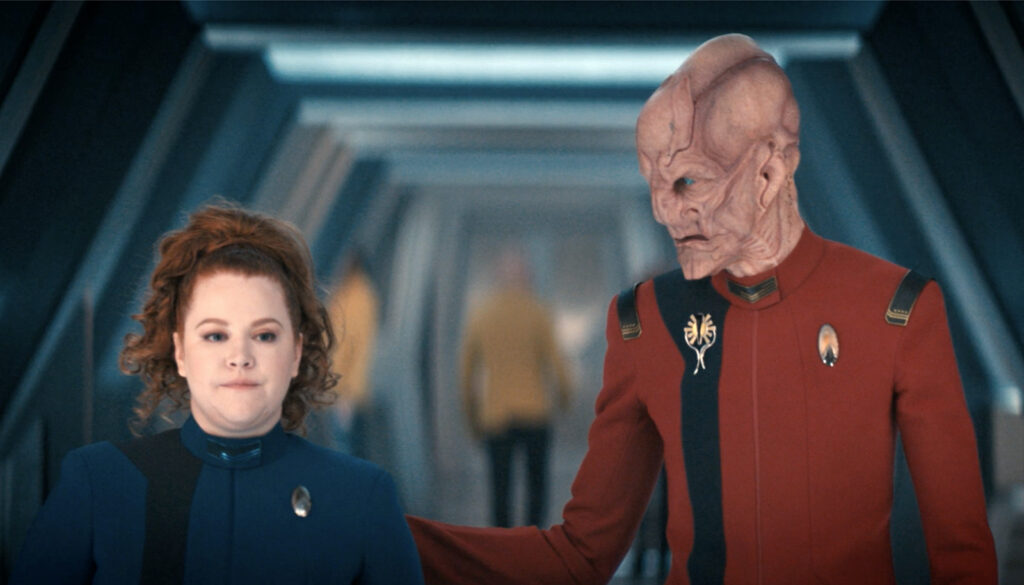
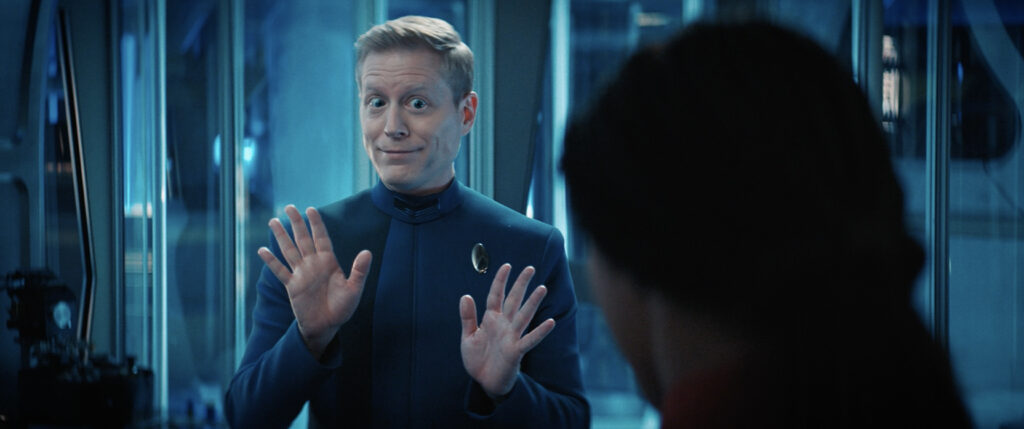

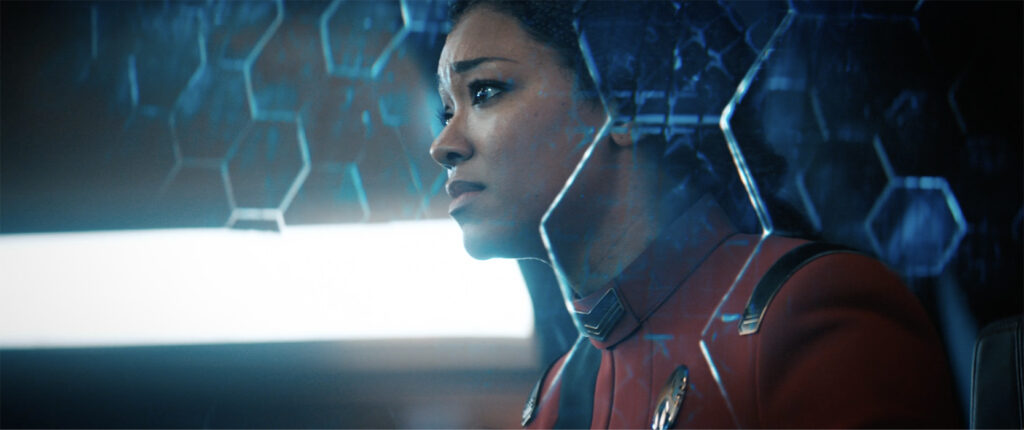
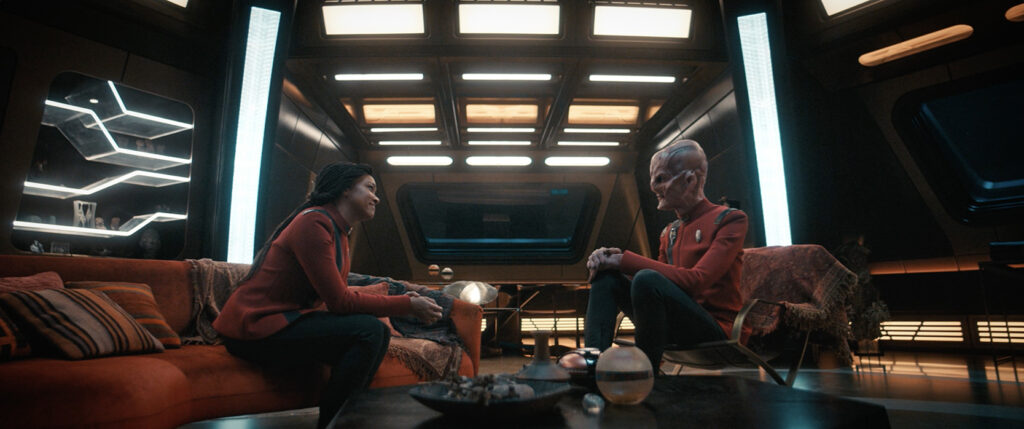
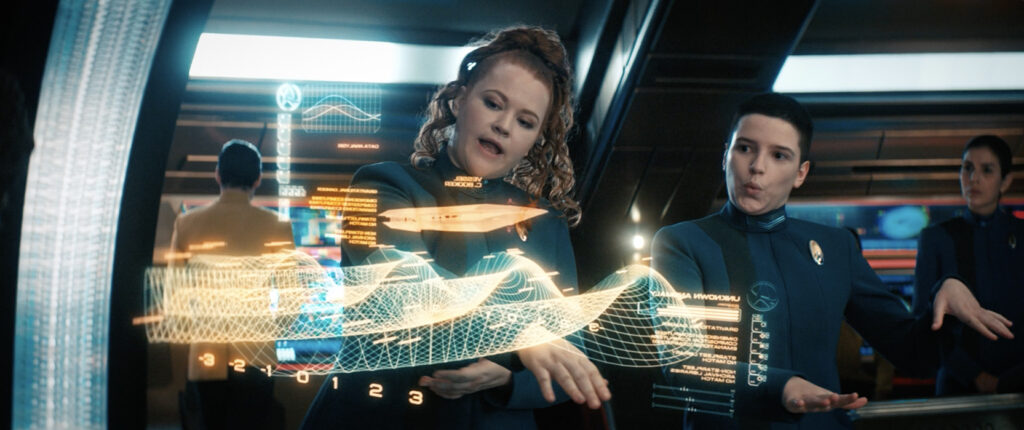
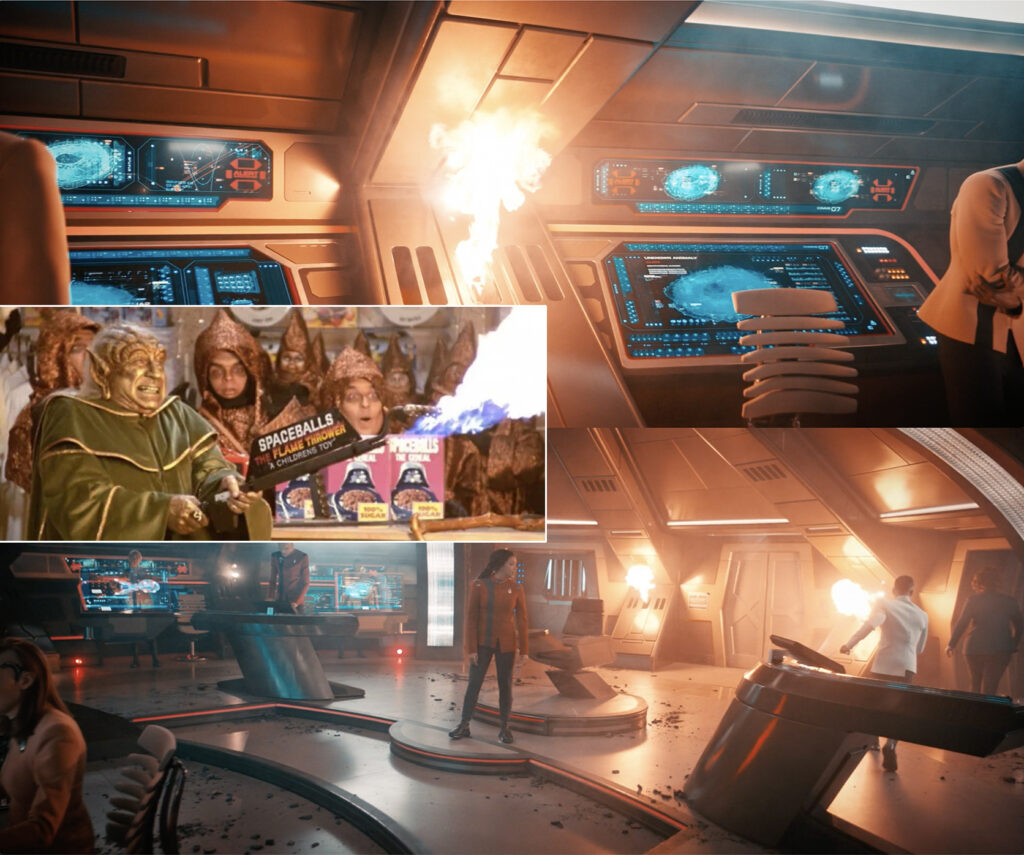
Hi Jonathan, thanks for the email notice.
I largely agree with pretty much everything in this review. I just hope the writers don’t go overboard and turn it into a space opera, (Syfy soap opera). I don’t need to know about every personal relationship. Crew mates interaction, fine. I especially enjoy Tignotero & Stamets, reminds me of Spock & McCoy always sparring, which was almost always funny too. The writers have failed miserably in all their attempts at group gatherings, with maybe one exception. Maybe they do better now that Philipa is gone? I would be interested to know what all the younger folks think about the series. I watch several reviews on YouTube, and it’s a mix of love / hate, like yours are. I’m guessing those reviewers are early thirties. What do the 20 something’s think,or are they even watching? I’m not on Facebook anymore, perhaps you could do a polling of the youngsters?
I suspect the 20-somethings are communicating their thoughts in 280 characters or less…or else making short TickTock video reviews with whacky filters for their faces. But I wouldn’t know because I’m old and still type out phases like “by the way” and “in my opinion.” 🙂